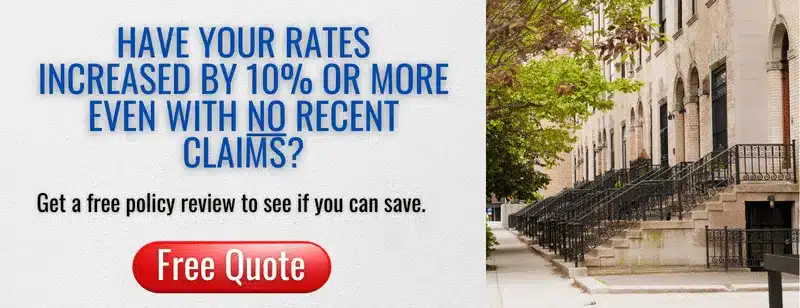How Replacement Cost and Actual Cash Value Impact Your Property Insurance

A large tree branch damages the roof. A leak on the top floor floods three units. A fire makes a unit uninhabitable. You compile a list of the damage, get repair estimates, and submit everything to your insurer. Will you get what everything is worth from the insurer? It depends on whether you’ve insured your property for replacement cost value or actual cash value. Here’s what that means.
The Difference Between Replacement Cost Value and Actual Cash Value
The value of property or other business assets can be insured and calculated in two ways:
- The cost of purchasing a new replacement (aka replacement cost value, or RCV).
- The cost when new, minus depreciation and wear and tear (aka actual cash value, or ACV).
For example, a windstorm damages your roof badly enough to require full replacement. The cost of a new roof is $20,000, and your deductible is $2,000.
Because of its age, materials and upkeep, your insurer estimates its current value is $5,800 less than it cost when new, or $14,200. With ACV, the insurer will pay $14,200 – $2,000, or $12,200. With RCV, the insurer will pay the full $20,000 (or whatever a new, equivalent roof will cost), less the $2,000 deductible.
Two Replacement Costs, Two Insurance Costs
Because the actual cash value of an item is generally less than the cost of a new item, insurance premiums are lower as well. The trade-off is lower premiums now versus lower reimbursements if a covered event damages your property or possessions. Keep in mind that not only will ACV pay less in the event of an insurance claim, but many items can’t be replaced for what they’re “worth” after depreciation and wear and tear. Will you find a used commercial pressure washer in good condition that’s like the one that was stolen or vandalized? Do you want a used unit that may not last to clean your property?
For many owners, the convenience of buying a new replacement is worth the higher premiums.
Replacement Cost Value and Actual Cash Value: Two Caveats
Depending upon the value of a building compared to the value of the land it sits on, the higher premiums for RCV coverage aren’t always the best financial move. For older buildings in a desirable location—say, most locations in the greater New York City area—selling the land if the building is destroyed by fire or a natural disaster may be a better financial option than rebuilding. In that case, an owner might choose to pay lower premiums for ACV coverage, accept a lower payout, and sell the land if a building is destroyed by a covered peril.
Conversely, insuring brownstones and other historic properties involves other challenges. Some policies may only cover functional, modern equivalents. An older building with lath and plaster walls might be repaired with modern drywall, or otherwise not accurately restored. Don’t assume that every policy will restore your building with historically accurate materials and techniques, which may be a requirement for those located in a designated historic area. Owners of brownstones and other historic buildings will need special insurance policies designed for these properties.
Policy Limits, Extended and Guaranteed Coverage
When evaluating building insurance policies, there’s one key factor to keep in mind and two options that building owners may wish to consider.
Policy Limits
Every policy, whether RCV or ACV, is subject to a limit. If a building is destroyed by a covered event, such as fire, and the cost to rebuild would be more than the policy limit, you’re responsible for the difference. Properties can easily be underinsured, especially if the owner has had the same policy for several years.
Extended Replacement Cost
Extended replacement cost coverage is an optional add-on to an insurance policy that will help cover the cost of rebuilding or repairing your building if the actual replacement cost exceeds the policy limit. Typically, this is expressed as a percentage, such as 25% over the policy limit.
Guaranteed Replacement Cost
This is just what it sounds like: in the event of a total loss, the insurer will pay the full cost of replacing a building, minus the deductible. Premiums may be higher, but so is peace of mind.
The Importance of an Expert Insurance Partner
Insuring a building can be complicated, and working with an expert you trust is critical. Because of the risks, this isn’t the type of policy to buy online with a few clicks. There is no “standard” building insurance policy that covers everything. Insurance coverage should be customized for each building and owner.
For a free insurance review or more information about insuring your building, please call City Building Owners Insurance at 877-576-5200.
